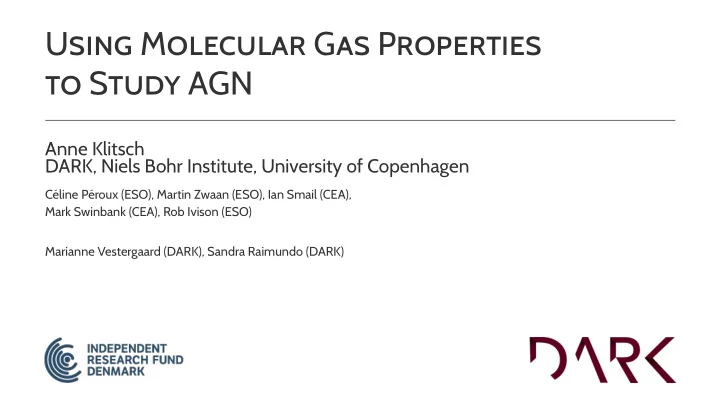

USING MOLECULAR GAS PROPERTIES TO STUDY AGN Anne Klitsch DARK, Niels Bohr Institute, University of Copenhagen Céline Péroux (ESO), Martin Zwaan (ESO), Ian Smail (CEA), Mark Swinbank (CEA), Rob Ivison (ESO) Marianne Vestergaard (DARK), Sandra Raimundo (DARK)
GAS FLOWS IN GALAXIES
Gas Flows in Galaxies on Different Scales c p k 0 1 > c p k 0 1 – 1 c p k 1 – 1 0 . c p 0 1 – 1 Strochi-Bergmann et al. 2019
Gas Flows into and out of Galaxies Tumlinson et al. 2018
Absorption-selected systems Our Tools and Aims � Use intervening absorbers to study gas flows on larger scales. � Study the multiphase ISM and CGM of the connected galaxies (neutral, ionized and molecular gas) � Find a connection with Nuclear activity? � Understand the flow of baryons into and out of galaxies
THE QUEST FOR ABSORBER HOST GALAXIES
D ifficult host galaxy identification � Until very recently: Only very few absorber host galaxies identified! ◦ gas rich ◦ not necessarily stellar mass rich
D ifficult host galaxy identification � Until very recently: Only very few absorber host galaxies identified! � Integral field spectroscopy is a game changer C. Péroux,AK+2019
D ifficult host galaxy identification � Until very recently: Only very few absorber host galaxies identified! � Integral field spectroscopy is a game changer � Molecular gas studies in progress C. Péroux,AK+2019
MOLECULAR GAS IN ABSORBER HOST GALAXIES
Gas mass / stellar mass vs. redshift � Molecular gas fraction is decreasing with decreasing redshift � Absorption-selected galaxies follow the same trend as emission-selected galaxies adapted from Fynbo et al. (2018)
SFR v s. molecular gas mass correlation � 12 molecular gas measurements for absorber host galaxies � High molecular gas masses and low SFE? � Most studies use Milky Way-type conversion factor and line ratios adapted from Kanekar et al. (2018)
THE ALMACAL SUR VEY
ALMACAL � U nique (sub)mm archival survey carried out by utilizing ALMA calibrator observations. � Up until today > 800 quasar fields observed ( > 2000 h). � Frequency setup depends on the science observations. � Cross match with known absorbers to search for CO emission from connected galaxies.
CO line detections from absorption-selected galaxies Klitsch et al. (2019)
M easuring molecular gas temperature and density Carilli & Walter (2013)
M olecular gas conditions in different galaxies Milky Way QSO BzK SMG 10 1 10 1 M82 Measuring the molecular gas temperature and density: 1) MW S J / S (2 10 0 10 0 Carilli & Walter (2013) 1 1 2 2 3 3 4 4 5 5 6 6 J
ISM conditions differ from Milky Way J0423B BzK J0238A M82 10 1 10 1 J0238A1 QSO Measuring the molecular gas Milky Way SMG temperature and density: 1) MW S J / S (2 10 0 10 0 Carilli & Walter (2013) 1 1 2 2 3 3 4 4 5 5 6 6 J
ISM conditions differ from Milky Way J0423B BzK J0238A M82 10 1 10 1 J0238A1 QSO � CO SLEDs deviate from Milky Way SMG MW 1) MW � Galactic conversion factors not applicable? S J / S (2 � Galactic line ratios not applicable? 10 0 10 0 � High masses in the literature overestimated? 1 1 2 2 3 3 4 4 5 5 6 6 J
M olecular gas masses overestimated?
I nteracting System Ionized Gas Chen+2005 � Galaxy A: active � Galaxy A1: starburst + AGN environment Molecular Gas � quasar or starburst like CO SLED Neutral Gas � Extended high column density (log N(HI) = 21.7) HI structure AK+19 Absorption selection → interacting/active systems?
SUMMARY
S ummary J0238A CO(3-2) � More evidence for groups associated CO(2-1) QSO to absorbers CO(4-3) Dec (J2000) � CO SLEDs of absorption selected galaxies suggest more excited ISM conditions → Absorption selection traces interacting/active systems? 10 kpc = 1.60" � Harbour a large amount of gas that can fuel the AGN RA (J2000) AK+2018,2019
S ummary J0423B BzK � More evidence for groups associated J0238A M82 10 1 10 1 J0238A1 QSO to absorbers Milky Way SMG � CO SLEDs of absorption selected 1) MW galaxies suggest more excited ISM S J / S (2 conditions → Absorption selection traces 10 0 10 0 interacting/active systems? 1 1 2 2 3 3 4 4 5 5 6 6 � Harbour a large amount of gas that J can fuel the AGN Klitsch et al. (2019)
S ummary J0238A CO(3-2) � More evidence for groups associated CO(2-1) QSO to absorbers CO(4-3) Dec (J2000) � CO SLEDs of absorption selected galaxies suggest more excited ISM conditions → Absorption selection traces interacting/active systems? 10 kpc = 1.60" � Harbour a large amount of gas that can fuel the AGN RA (J2000) AK+2018,2019
Recommend
More recommend